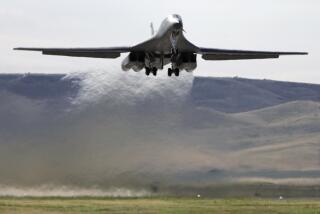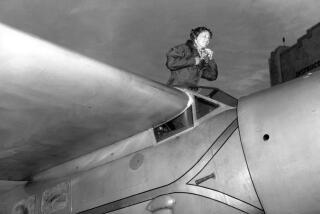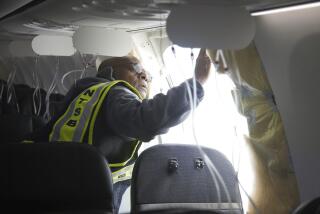A-10 Rubble Identified in Colorado; Pilot Still Missing
EAGLE, Colo. — After a harrowing recovery operation Wednesday, the U.S. Air Force confirmed that wreckage high on a remote Colorado mountain is that of an A-10 attack bomber missing since April 2.
A recovery expert hanging 100 feet below a hovering helicopter retrieved two pieces of metal from an ice-encrusted cliff 13,000 feet up the mountainside. The two parts--a bent engine blade and a clump of wiring--carried manufacturers’ numbers matching those of the missing A-10 Thunderbolt, Maj. Gen. Nels Running said at a news conference.
“The aircraft debris at the site in the New York mountains near Gold Dust Peak is in fact our A-10 missing aircraft,” Running said. “But the search for the pilot continues. . . . We have no evidence he was with the plane when it met the mountain.”
The advanced mountaineer lowered from the belly of a MH-53 heavy-lift helicopter--the most powerful helicopter in the Air Force--spent only 15 minutes at the crash site in the Sawatch range about 15 miles southeast of the Vail ski resort.
A four-person team of rescuers was ferried to a natural bowl about 1,000 feet below the crash site to begin searching for the body of the pilot, Capt. Craig Button. The team planned to spend the night on the mountain and then start probing the snow, gingerly, with poles on Thursday.
Their effort is complicated by ground-hugging clouds and myriad potential hazards presumed buried under 10 feet of snow on an 80-degree slope: chunks of twisted metal, flares, hundreds of rounds of 30mm cannon ammunition and four 500-pound general-purpose bombs.
Given the additional danger of avalanches in this region of craggy peaks, deep valleys and strong wind currents, the searchers have been ordered to avoid any digging.
A strong weather front was expected to dump several inches of snow throughout the region over the next few days. The team is carrying enough supplies to last three days.
“We’re going to do everything we can to keep track of where they are,” said Col. Denver Peltcher. “If something comes up we are prepared to go get them.”
Running said a priority will be to remove the plane’s ordnance, but that may not be possible until the snow melts later this summer.
Any ordnance discovered over the next few weeks by searchers will be marked with a flag so that experts can defuse the explosives.
U.S. Forest Service authorities have suggested leaving the remainder of the estimated 30,000 pounds of wreckage on the mountain because removing it could cause damage to the wilderness ecology.
As a warning to hikers who might venture into the area over the weekend, Running said: “This is not a place for fun and games. If you are smart you’ll stay out.”
Now that the plane has been identified, Running said a safety investigation board will be appointed to investigate why Button mysteriously broke away from a three-plane formation over southern Arizona and then headed 800 miles northeast to Colorado.
His disappearance occurred about 15 minutes after he refueled while flying from Davis-Monthan Air Force Base in Tucson to the Barry M. Goldwater bombing range.
This much is known: Button was at the low-end of the range of his fuel by the time radar images and eyewitnesses saw his slow-moving tank destroyer making a tight circle over the Vail area about 12:40 p.m.
Some reported hearing an explosion and seeing smoke rising from the steep mountainside where bits of metal, wires and paper are now scattered across several hundred yards in all directions.
Was he looking for a place to land? Had he lost his bearings because of oxygen deprivation--a condition known as hypoxia--and slammed into the granite mountain face? Did he deliberately intend to end his life after a spectacular joy ride? Is he surviving somewhere in the snow-covered wilderness after bailing out?
Air Force officials had been reluctant to speculate on answers to those questions. But in an interview, Running downplayed the possibility that Button may have been suffering from the mind-altering influence of hypoxia, perhaps brought on during the aerial refueling.
“I can’t buy the idea that he gets a certain level of hypoxia and flies 800 miles to a different state through mountains and valleys and whatnot and then his fuel runs out and he’s gone,” he said.
“Right now, we can’t see anything that even suggests he was with the plane when it went down.”
Maj. Richard Dopierala, of the physiology training center at Peterson Air Force Base in Colorado Springs, disagreed.
“Hypoxia can do all kinds of things specific to an individual, and it is insidious--let it go and it’ll whack you,” he said. “Any number of things could have caused this. You can’t say it’s not one of them until they do an investigation.”
More to Read
Sign up for Essential California
The most important California stories and recommendations in your inbox every morning.
You may occasionally receive promotional content from the Los Angeles Times.











